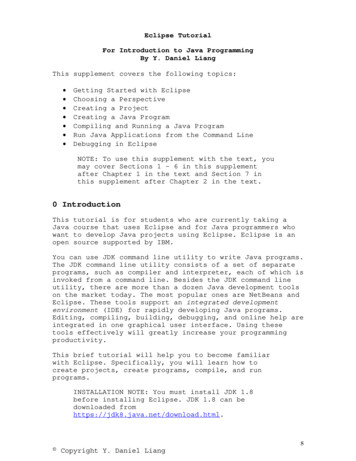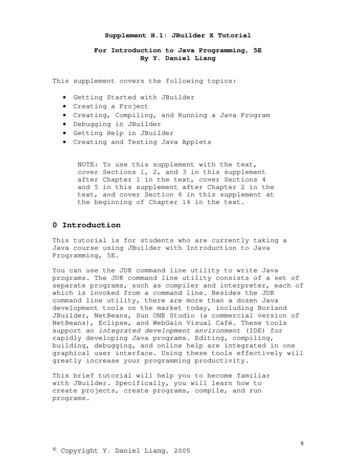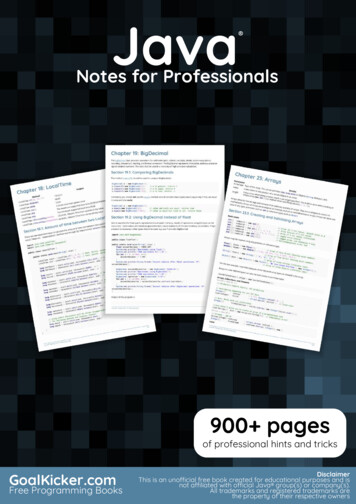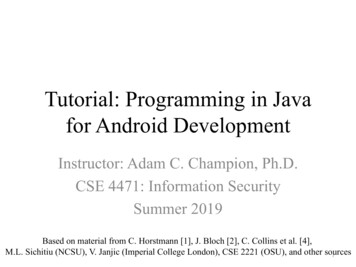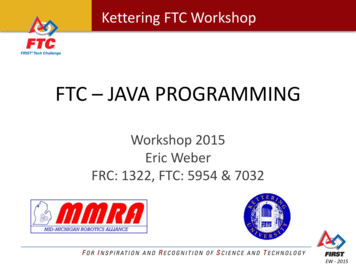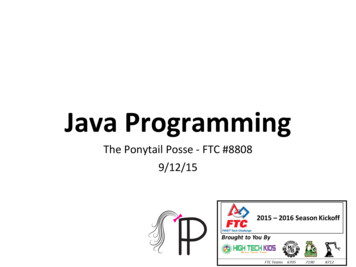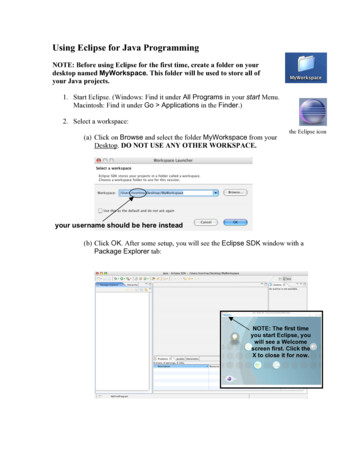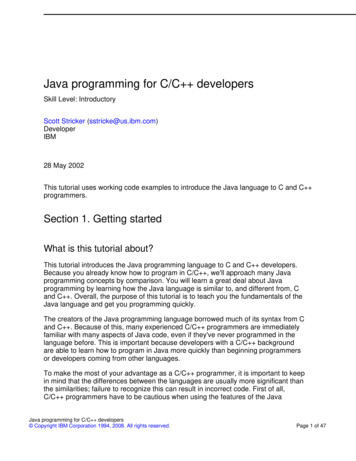
Transcription
Java programming for C/C developersSkill Level: IntroductoryScott Stricker (sstricke@us.ibm.com)DeveloperIBM28 May 2002This tutorial uses working code examples to introduce the Java language to C and C programmers.Section 1. Getting startedWhat is this tutorial about?This tutorial introduces the Java programming language to C and C developers.Because you already know how to program in C/C , we'll approach many Javaprogramming concepts by comparison. You will learn a great deal about Javaprogramming by learning how the Java language is similar to, and different from, Cand C . Overall, the purpose of this tutorial is to teach you the fundamentals of theJava language and get you programming quickly.The creators of the Java programming language borrowed much of its syntax from Cand C . Because of this, many experienced C/C programmers are immediatelyfamiliar with many aspects of Java code, even if they've never programmed in thelanguage before. This is important because developers with a C/C backgroundare able to learn how to program in Java more quickly than beginning programmersor developers coming from other languages.To make the most of your advantage as a C/C programmer, it is important to keepin mind that the differences between the languages are usually more significant thanthe similarities; failure to recognize this can result in incorrect code. First of all,C/C programmers have to be cautious when using the features of the JavaJava programming for C/C developers Copyright IBM Corporation 1994, 2008. All rights reserved.Page 1 of 47
developerWorks ibm.com/developerWorkslanguage that behave differently from their C/C counterparts, such as booleanexpressions and default parameter passing by reference instead of passing byvalue. Second, C/C programmers have to learn how to get along without manyC/C language features on which they have previously relied, such as pointers,global variables, and the preprocessor.Should I take this tutorial?This tutorial is geared toward C and C programmers. If you already know C orC and want to learn how to program in the Java language, this tutorial is for you. Ifyou don't know C or C , but still want to learn the Java programming language, youmay want to check the listings in Resources for a tutorial that is better suited to yourbackground.As far as this tutorial goes, it doesn't particularly matter if you're a C programmer ora C programmer; we'll discuss the differences between the C and C languagesas they come up. Despite what many people think, C and C really are differentlanguages. Many C programmers have never programmed in C , and arecompletely unfamiliar with object-oriented programming. Likewise, many C programmers have learned object-oriented programming using C and are notproficient in a purely C, procedural programming environment.What do I need to take this tutorial?In this tutorial, we'll be compiling and running Java programs, so you'll need a Javadevelopment environment of some kind. There are several integrated developmentenvironments (IDEs) on the market. These are intended to help you develop Javaprograms quickly and easily. An even better tool for beginners is the Java SoftwareDevelopment Kit (SDK), which is a collection of very simple command-line tools forprogramming on the Java platform.While you will almost certainly migrate to some other, more advanced Javaprogramming environment, there are several good reasons to start out using theSDK. First, the SDK provides a standard implementation of the tools we'll need tocompile and run Java programs. Second, as newer versions of the Java platform arereleased, Sun's SDK is usually the first and only up-to-date implementationavailable. Third, the SDK tools are simple, low-level command-line tools; using themprovides you with a better understanding of how the Java platform actually works.Last, and perhaps most importantly, the SDK is available for free from Sun's JavaWeb site.The SDK doesn't come with a text editor, so you'll need one of those as well. AnyJava programming for C/C developersPage 2 of 47 Copyright IBM Corporation 1994, 2008. All rights reserved.
ibm.com/developerWorksdeveloperWorks text editor will do, so long as it can save files in plain ASCII format. For example, onWindows, you can use Notepad or DOS Edit; on UNIX you can use emacs or vi;and on the Macintosh you can use SimpleText.You may also want to download the entire example source now, to make it easier tofollow along with the exercises in this tutorial. See Resources for links to download aJava SDK, a text editor, and the original source code for this tutorial.Note: Since the purpose of this tutorial is to teach you the Java programminglanguage, you will not need to compile any C or C programs to follow along withthe exercises here. We will make use of C/C code from time to time, and you mayfind it instructive to compare C/C and Java code by running programs, but doingso is not a required exercise for this tutorial.Historical backgroundThe C programming language was developed in the early 1970s. C was originallydesigned to facilitate the writing of operating systems (OSs) and OS utility programs.At first, it was almost exclusively associated with UNIX. Later, C became a moregenerally used application development language across multiple platforms. In themiddle of the 1980s, C became an official ANSII standard.The C programming language was developed in the early 1980s. C wasdesigned to add object-oriented programming techniques to the C language.Although C originally tended to be associated with systems programming, it hasevolved into a mature programming language that is well-suited for a wide variety ofapplication programming. In the early 1990s, C became an official ANSII and ISOstandard.The Java programming language and platform was developed in the early 1990s.The Java platform was originally designed to be used in consumer electronicdevices (television sets, handheld devices, toasters, and the like), so the languagehad to be small, highly-portable, and efficient. Although the language never reallycaught on in digital devices, these same features made it ideally suited for theInternet. The Java language secured its place as an Internet technology after theNetscape Navigator and Internet Explorer Web browsers began to support Javaapplets. Since then, the Java language has continued to evolve and mature into aplatform for enterprise application development.Java programming for C/C developers Copyright IBM Corporation 1994, 2008. All rights reserved.Page 3 of 47
developerWorks ibm.com/developerWorksSection 2. Setting upIntroducing the SDKThe Java Software Development Kit (SDK) is a group of command-line tools andpackages that you will need to write and run Java programs. The most important ofthese tools are the Java compiler (javac.exe), which you use to compile Javaprograms, and the Java interpreter (java.exe), which you use to run Javaprograms. The SDK also includes the base classes (called the Java platform), whichwill provide you with the basic functionality and APIs you'll need start writingapplications.Sun has released an SDK for every one of its five major releases of the Javaplatform. Although I recommend that you get the latest version of the SDK (Java 1.4)for this tutorial, we'll briefly review all the versions. Java 1.0 was the first public release of the Java platform. Because manyWeb browsers still use this version, many Java applets are still written tobe compliant with Java 1.0. Java 1.1 represented a vast improvement in the Java platform. Java 1.1was the first Java platform stable enough to develop robust Javaapplications. Java 1.2 was such a leap forward for the Java platform that it wasofficially dubbed Java 2. This version of the Java platform is specificallywell-suited for enterprise application development. Java 1.3 includes support for the Java Naming and Directory Interface(JNDI), Java Sound, and support for RMI over IIOP. It also includes anew, high performance just-in-time (JIT) compiler. Java 1.4, also known as Merlin, is the latest release of the Java platform.Java 1.4 includes support for XML processing, the Java CryptographyExtension (JCE), the Java Secure Socket Extension (JSSE), and the JavaAuthentication and Authorization Service (JAAS).Note that Sun's development kit was called the Java Development Kit (JDK) prior tothe release of Java 2. Thereafter, the development kit was officially renamed theSoftware Development Kit (SDK).Java programming for C/C developersPage 4 of 47 Copyright IBM Corporation 1994, 2008. All rights reserved.
ibm.com/developerWorksdeveloperWorks You can download the Java SDK of your choice for free from Sun's Java Web site(see Resources).Installing the SDKOnce you download the SDK, you'll need to install it on your machine. Theinstallation is pretty simple -- it should run just like most standard installationprograms. If you're given the option between a typical or custom install, you shouldchoose the typical install. You should only choose the custom install if you knowexactly what you do and do not want to load on your machine.You can download the API documentation for the Java platform separately, as acompressed file. This is a collection of HTML documents that you can navigate in astandard Web browser. Since the API documentation is an essential reference thatyou'll probably use a lot in the future, you may want to go ahead and get it now.When you are installing, you'll usually be given the option of installing the sourcecode for the standard Java platform classes. If you have sufficient memory on yourmachine, I recommend that you take this option. These files will give you a chanceto look at the implementation of the classes that make up the Java language andstandard APIs. These classes are particularly well designed and implemented, andyou can learn a lot from studying this code.After the SDK is installed, you may need to configure it to work on your system. Howyou configure the SDK will depend on your operating system and the SDK versionyou're using. Complete installation and configuration instructions will be providedwhen you download the SDK.Section 3. Working with the SDKYour first Java programBefore we begin talking about the structure and syntax of the Java language, let'sjust work with the SDK a little bit. We'll start by using the SDK's command-line toolsto compile and run a Java program. Because the syntax of the Java programminglanguage is very similar to C and C , you should be able to follow most of the codein this non-trivial example.Java programming for C/C developers Copyright IBM Corporation 1994, 2008. All rights reserved.Page 5 of 47
developerWorks ibm.com/developerWorksIn the next section, you will find the source code for a Java class called Factorial.The Factorial class computes the factorial of an integer. As you may recall, thefactorial of a number n is the product of all integers from 1 to n. So, for example, thefactorial of the number 5 is 5 x 4 x 3 x 2 x 1 120.In this exercise, you will pass in a value as a command-line argument and theFactorial class will attempt to compute the factorial of that number. As in C,command-line arguments are passed into Java applications as strings, so theFactorial class will attempt to transform the string argument into a valid integer. Ifyou pass in non-digit characters, Factorial will generate an exception.Factorial.java sourceJava source files use the java extension, and every Java source code file musthave the exact same name as the class that is defined inside of it. Since our firstclass is called Factorial, we need to save it in a file called Factorial.java.Open your text editor and enter the source below exactly as you see it. When youare done, save it in a file called Factorial.java. You may save it in anyappropriate directory on your machine. You'll need to go to this directory to use thecommand-line tools, so make sure it is convenient for you.public class Factorial {public static void main(String[] args) {if(args.length ! 0) {int num rial(num));}}private static int factorial(int fact) {int result fact;if (fact 0)return result;else {while (fact ! 1)result * --fact;}return result;}}Compiling the programOnce you've saved Factorial.java on your machine, you are ready to compilethe program. The Java compiler that comes with the SDK is a command-lineapplication called javac.exe. To compile a Java source code file, simply pass theJava programming for C/C developersPage 6 of 47 Copyright IBM Corporation 1994, 2008. All rights reserved.
ibm.com/developerWorksdeveloperWorks name of the .java file to the javac.exe program. To compile your Factorialprogram, open a command-line prompt and change your directory to the locationwhere you saved the Factorial.java file. Then type this command:javac Factorial.javaJust like a C or C compiler, the Java compiler may generate any number of errors.Naturally, you'll need to correct all the errors before the Java compiler willsuccessfully compile the Factorial program. Once the Java compiler is able tosuccessfully compile, it will generate a class file called Factorial.class. Thisrepresents the executable that we'll run in the Java interpreter.There are several options you can use with the javac compiler. Type javac-help at the command line to see a usage message and a list of valid options.Running the programThe Java interpreter that comes with the SDK is a command-line application calledjava.exe. To run a Java bytecode executable, you simply pass the name of theJava program to the Java interpreter. Be sure that you do not specify the .classextension when using the Java interpreter. This program expects only class files, soit will produce an error if you explicitly write the .class extension.To run your Factorial program, open a command-line prompt and change yourdirectory to the location where you compiled the Factorial.java file. That'swhere your bytecode executable file, Factorial.class, should be. Then type thiscommand:java Factorial 5The Java interpreter will try to execute the main() method of the Factorialprogram. A Java method is basically the same thing as a C/C function. Theargument that we specified on the command line is 5, and the Java interpreter willpass this argument into the main() method as a parameter -- specifically an arrayof String objects.The Java interpreter may report a run-time error, which will usually terminateprogram execution. As in C and C , Java run-time errors are more difficult todebug than compile-time errors. Since Java programs are executed in a virtualmachine (that is, the Java interpreter) run-time errors can be handled in a gracefulway. Whereas C and C programs may simply crash, the Java interpreter will atleast report the run-time error that caused program execution to halt.Java programming for C/C developers Copyright IBM Corporation 1994, 2008. All rights reserved.Page 7 of 47
developerWorks ibm.com/developerWorksThere are several options that you can use with the Java interpreter. Type java-help at the command line to see a usage message and list of valid options.What you've learned about the SDKWe'll be compiling and running more Java applications in this tutorial, so let's goover the process once again. You may need to refer back to this section later.1.Write your Java source code program in a text editor and save it with a.java extension. Make sure that your text editor saves the file in plainASCII format, and make sure that it supports long file names. You can'tsave a Java program as a .jav file -- the extension has to be .java.2.Compile your program from a command-line prompt, using the javaccompiler that comes with the SDK. For example, for a source code filenamed Sample.java, you would type javac Sample.java. If all goeswell, a Java class file will be produced. In our example, this file would becalled Sample.class. Remember to always specify the .javaextension when compiling a Java program.3.Run your program from a command-line prompt, using the javainterpreter that comes with the SDK. For example, to run the Sampleprogram from the previous step, you would type java Sample. Tospecify command-line arguments to a Java program, simply type themafter the program name, separated by spaces. Remember to neverspecify the .class extension when running a Java program.4.Errors can occur when compiling or running a Java program. As youknow, run-time errors are more difficult to debug than compile-time errors.When you are new to a language, however, compile-time error messagescan seem very cryptic. Correcting compile-time errors can be veryinstructive, but if you can't get any of the examples in this tutorial to work,try using the example code (in Resources) instead.Section 4. Introducing the Java languageJava programming for C/C developersPage 8 of 47 Copyright IBM Corporation 1994, 2008. All rights reserved.
ibm.com/developerWorksdeveloperWorks OverviewNow that you have a basic idea of what Java code looks like and how to compile andrun it on your test machine, we can begin to talk more in depth about the structureand syntax of the Java programming language.In this section, we'll learn about the Java programming environment and the Javaprimitive data types. Because you are familiar with programming in C/C , andbecause the Java language has much in common with these languages, we'll learnby comparison. In the sections that follow, we'll discuss the fundamentalcomponents of the Java platform, describing each one in terms of its relation to ordifference from a similar component underlying the C/C programming framework.C and C execution environmentsC and C are high-level programming languages; their purpose is to make it easierfor human beings to develop computer programs. Computers cannot understandhigh-level languages -- they can only understand low-level machine languages. Amachine language consist of a sequence of binary instructions that can be directlyexecuted on a computer's processor. For this reason, programs written in high-levellanguages must be translated into machine language programs, which are calledexecutables, before they can be run on a computer.Two methods are available for translating a high-level programming language intomachine language executables: compilation and interpretation. Compilation involvestranslating an entire high-level program into a whole machine language program,which can then be executed in its entirety. Interpretation involves translating ahigh-level program into machine instructions line-by-line; one line is translated andexecuted before the next line is reached. Compilation and interpretation are logicallyequivalent, but compiled programs tend to execute faster than interpreted programs.C and C programs are compiled into machine language executables by a programcalled a compiler. C compilers and C compilers are different. A C compiler cancompile C source code files but not C source code files. Since C is retained as asubset of C , a C compiler can compile both C and C programs.Different computers use different machine languages. An executable that runs onone machine will not run on another machine that uses a different machinelanguage. In order to run on different computers, a C or C source code file mustbe recompiled on different compilers; one for each type of machine, or platform, onwhich the executable will be run.Java programming for C/C developers Copyright IBM Corporation 1994, 2008. All rights reserved.Page 9 of 47
developerWorks ibm.com/developerWorksThe Java execution environmentLike C and C programs, Java programs are compiled. Unlike C and C programs, Java programs are not compiled down to a platform-specific machinelanguage. Instead, Java programs are compiled down to a platform-independentlanguage called bytecode. Bytecode is similar to machine language, but bytecode isnot designed to run on any real, physical computer. Instead, bytecode is designed tobe run by a program, called a Java virtual machine (JVM), which simulates a realmachine.Simply put, the JVM is an interpreter that translates Java bytecode into real machinelanguage instructions that are executed on the underlying, physical machine. Morespecifically, the term Java virtual machine is used generically to refer to any programthat executes Java class files. The Java interpreter program, java.exe, is aspecific JVM implementation. The Java Runtime Environment (JRE) is anotherexample of a JVM implementation.The Java platform uses the virtual machine layer to ensure that programs written inthe Java language are platform independent. Once a Java program is compileddown to bytecode, it can be run on any system that has a JVM. Whereas a C or C program must be recompiled for each platform on which it is to be executed, a Javaprogram needs to be compiled only once; it can then run on any machine that has aJVM installed.Comparison of execution environmentsLet's say you're going to write an application and you want it to run on threeplatforms: Windows, UNIX, and Macintosh. If you're writing the code in C or C ,you're going to have to compile your code three times, using the correct compiler foreach of the three platforms. Of course, this is assuming that you can use the samecode base without modification for each compiler. Very often, you'll need to modifyyour code to get it to compile, because you will probably use different APIs for eachplatform. In other words, you might have to write three different versions of yoursource code, one for each target platform.Now, let's say you choose to write your application using the Java platform. In thiscase, all you have to do is write the Java code and compile it once. Since each ofthe three target platforms has a JVM implementation, you can run the samecompiled bytecode on all of them, without modification. It doesn't matter if youcompile the Java code on a Windows machine, a UNIX machine, or a Macintosh; itwill run on any platform with a JVM.Java programming for C/C developersPage 10 of 47 Copyright IBM Corporation 1994, 2008. All rights reserved.
ibm.com/developerWorksdeveloperWorks The figure below illustrates how a program is compiled and executed in both theJava programming environment and a C/C environment:Primitive data typesMany of the primitive data types defined by the Java programming language havenames that are the same or similar to the fundamental data types defined in C.Despite the similarity in their names, all of the Java primitives are different from theirC/C equivalents.In general, C and C do not define strict sizes for their fundamental types. In otherwords, most of the aspects of the C/C fundamental types are defined by thecompiler, so different compilers often represent fundamental types in different ways.You are forced to deal with this issue if you want your C/C code to be portable.The Java programming language, on the other hand, guarantees the size, range,and behavior of its primitive types. No matter what Java compiler you use, theJava programming for C/C developers Copyright IBM Corporation 1994, 2008. All rights reserved.Page 11 of 47
developerWorks ibm.com/developerWorksprimitive data types will always be represented in the exact same way. Thiseffectively isolates you from the details of the compiler's implementation.The char types// Ccharcharcharcharcharcharchar examplesletterJ 'J';letterA 'A';letterV '\126';digit0 '\x030k';digit1 '1';digit2 '2';// Java charchar letterJchar letterAchar letterVchar digit0char digit1char digit2examples 'J'; 'A'; '\u0056'; '\u0030'; '1'; '2';Both the C and Java languages have a char type, which is used to representcharacters. Although these types have the same names and uses, they arerepresented in completely different formats.The C char type is used to hold a character. The compiler determines the characterset and the size of the values that are stored in the char type. Typically, the C chartype represents an ASCII character, and uses 8 bits (including the sign bit), yieldinga range of values from -128 through 127. Because there is no standard, however,many problems can arise from using the C char type, which causes many portabilityissues.The Java char type is also used to store a character, but in this case the languagestrictly defines the character set and size of the char type. A Java char representsa character from the Unicode character set, and is stored in 16 bits (with no sign bit),yielding a range of 0 through 65,536. As in C, character literals are written withinsingle quotes.The Unicode character set is capable of representing most of the characters used inthe world's major written languages. You can encode a Unicode character in anASCII file using the \u escape sequence, followed by a hexadecimal numberrepresenting a Unicode character. See Resources to learn more about the Unicodespecification.Java programming for C/C developersPage 12 of 47 Copyright IBM Corporation 1994, 2008. All rights reserved.
ibm.com/developerWorksdeveloperWorks Character escape sequencesAs in C, Java characters and strings can use escape sequences to represent specialcharacters. Most of these escape sequences are the same as those defined in C,but not all C escape sequences are valid Java escape sequences. The followingtable shows the valid Java escape sequences that are inherited from C:Escape sequenceCharacter value\bBackspace\tHorizontal tab\vVertical tab\nNew line\bBackspace\fFormFeed\rCarriage return\"Double quote\'Single quote\\BackslashIn addition to the sequences above, C and C also define the alert (\a), questionmark (?), and hexadecimal and octal number escapes (\xhhh and \ooorespectively). These are not valid Java escape sequences.Java and C integer types// C integerslong int val 1longval 2intval 3short int val 4shortval 5 250000;0x36B;-1800;017;-25;// Java integerslong val 1 250000;long val 2 0176;intval 3 0x3F;short val 4 -93;short val 5 25;byte val 6 120;byte val 7 -34;Java programming for C/C developers Copyright IBM Corporation 1994, 2008. All rights reserved.Page 13 of 47
developerWorks ibm.com/developerWorksBoth C and Java define an integer type named int. In addition, the Java languagealso defines the long and short types, which originate from the type modifiers ofthe same names in C and C . The Java integer type byte has no counterpart in C.You can write Java integer values as octal or hexadecimal numbers using the sameformat as C/C . Octals start with a 0 and hexadecimals start with a 0x.The int type in C is used to store a signed whole number value. The exact size ofthe int type is specified by the compiler, but in general the int type is 16 bits(including a sign bit), yielding a range of -32,768 through 32,767.The Java int type is also used to store a signed whole number. The Java languagestrictly defines the size of the int type as 32 bits (including a sign bit), yielding arange of -2,147,483,648 through 2,147,483,647.The C and C languages define a set of type modifiers, which have an effect onthe way the compiler stores an int value. The long modifier usually forces thecompiler to use 32 bits to represent an int, and the short modifier usually forcesthe compiler to use 16 bits to represent an int. C also defines the signed andunsigned modifiers, which have no counterpart in the Java language; Java integersare always signed values.The Java long type is used to store a signed whole number using 64 bits (includinga sign bit), yielding a range of -9,223,372,036,854,775,808 through9,223,372,036,854,775,807. The Java short type is used to store a signed wholenumber using 16 bits (including a sign bit), yielding a range of -32,768 through32,767. The Java language also defines the byte type, which is used to store asigned whole number using 8 bits (including a sign bit), yielding a range of -128through 127.The floating-point types// C floating-pointsfloat val 1 0.25f;float val 2 12.4901f;float val 3 25.138e-10f;double val 4 0.123456789;double val 5 1.9876540e5;double val 6 l 1 0.25f;val 2 12.4901f;val 3 25.138e-10f;Java programming for C/C developersPage 14 of 47 Copyright IBM Corporation 1994, 2008. All rights reserved.
ibm.com/developerWorksdeveloperWorks double val 4 0.123456789;double val 5 1.9876540e5;double val 6 0.000001234;Both C and Java define floating-point types named float and double, whichrepresent single- and double-precision floating-point values, respectively. Javafloating-point types are, however, represented in a completely different format fromtheir C/C counterparts. As in C, Java floating-point values can be representedwith an exponential portion.The float type in C is used to store a signed floating-point number value. Theexact size of the float type is specified by the compiler, but in general the int typeis 32 bits (including a sign bit), yielding a range of approximately -34.4E-38 through3.4E 38. The float type can generally be used safely to store values of six toseven digits of precision.The Java float is also used to store signed floating-point number values, but thelanguage specifies that 32 bits (including a sign bit) are always used to store IEEE754 floating-point values. Floating-point literals are assumed to be of type double,so if you specify a float literal you need to append the letter f or F.The double type in C is used to store a signed floating-point number value. Theexact size of the double type is specified by the compiler, but in general thedouble type is 64 bits (including a sign bit), yielding a range of approximately-1.7E-308 through 1.7E-308. The double type can generally be used safely to storevalues of 14 to 15 digits
This tutorial is geared toward C and C programmers. If you already know C or C and want to learn how to program in the Java language, this tutorial is for you. If you don't know C or C , but still want to learn the Java programming language, you may want to check the listings in Resources for a
